Otwock
Place in Masovian Voivodeship, Poland From Wikipedia, the free encyclopedia
Place in Masovian Voivodeship, Poland From Wikipedia, the free encyclopedia
Otwock [ˈɔtfɔt͡sk] (Yiddish: אָטוואָצק) is a city in the Masovian Voivodship in east-central Poland, some 23 kilometres (14 mi) southeast of Warsaw, with 44,635 inhabitants (2019). Otwock is a part of the Warsaw metropolitan area. It is situated on the right bank of Vistula River below the mouth of Świder River. Otwock is home to a unique architectural style called Świdermajer.
Otwock | |
|---|---|
 Świdermajer-styled house in Otwock | |
| Coordinates: 52°7′N 21°16′E | |
| Country | |
| Voivodeship | |
| County | Otwock |
| Gmina | Otwock (urban gmina) |
| Established | 1877 |
| City rights | 9 November 1916 |
| Government | |
| • City mayor | Jarosław Margielski (PiS) |
| Area | |
| • Total | 47.33 km2 (18.27 sq mi) |
| Elevation | 100 m (300 ft) |
| Population (2019) | |
| • Total | 44,635 |
| • Density | 940/km2 (2,400/sq mi) |
| Time zone | UTC+1 (CET) |
| • Summer (DST) | UTC+2 (CEST) |
| Postal code | 05-400 to 05-402 |
| Area code | +48 022 |
| Car plates | WOT |
| Highways | |
| Voivodeship roads | |
| Website | http://www.otwock.pl |
It is the capital of Otwock County. The town covers the area of 47 square kilometres (18 sq mi). Forested areas make up 23% of the territory, and there are several nature reserves.

Even though the first mention of a village called Otwosko comes from the early 15th century, Otwock did not fully develop until the second half of the 19th century, when in 1877 the Vistula River Railroad was opened, which ran from Mława via Warsaw, to Lublin and Chełm. Otwock, which is located along the line, became a popular suburb, with numerous spas and several notable guests, including Józef Piłsudski and Władysław Reymont, who wrote his Nobel prize-winning novel Chłopi there. The Zofiówka Sanatorium was opened in Otwock in 1908. In 1916, Otwock was incorporated as a town and became the seat of a powiat.
During the Battle of Warsaw (1920), Otwock, along with nearby Karczew, constituted the edge of the right wing of the first line of Polish defense and was manned by the Polish 15th Infantry Division, whereas the second line of Polish defense began in the present-day neighborhood of Świdry Wielkie; however, there was no Polish-Russian fighting in Otwock.[1]
In 1936 the Warsaw - Otwock railway connection was the first rail line to be electrified in Poland.

Following the German–Soviet invasion of Poland, which started World War II in September 1939, the town was occupied by Germany. In December 1939, the German authorities established a Jewish ghetto in Otwock. A murderous Action T4 euthanasia program was carried out by the Nazis in the local Zofiówka Sanatorium for the psychiatric patients[2] in order to confine its Jewish population for the purpose of persecution and exploitation.[3] The Ghetto was liquidated between August and 19 September 1942, when 75% of its Jewish population of 12,000–15,000 numbering at around 8,000 were assembled by the Nazis at a layover yard in Otwock (pictured) and transported in cattle trucks to extermination camps in Treblinka and Auschwitz.[4] Jews who remained were summarily shot at Reymonta Street soon after.[5]

Otwock is the hometown of Irena Sendler (1910 – 2008), the Polish humanitarian who saved thousands of Jewish children during the Holocaust; as well as Krystyna Dańko, both awarded the titles of Righteous among the Nations by Yad Vashem. Writer Calel Perechodnik, a Jewish Ghetto Policeman from Otwock also hailed from this town. Following the liberation, a children's home for Holocaust survivors was established in Otwock.[6]
In 1952, the town's limits were expanded by including Świder, Świdry Wielkie, Teklin and Zamlądz as new neighbourhoods.[7] Following the Korean War, in 1953–1959, Poland admitted 200 North Korean orphans in Świder.[8]
From 1975 to 1998, it was administratively located in the Warsaw Voivodeship.
In Otwock there are many buildings in the Świdermajer style, unique to the town and its surroundings. There are also memorials to Józef Piłsudski and to local Jews, who were murdered by Nazi Germany in the Holocaust.
The Mszar Pogorzelski, Świder and Wyspy Świderskie nature reserves are located in Otwock.
In 1958, Ewa, the first Polish nuclear reactor was activated in Swierk district of Otwock. A second research reactor, Maria, was erected in 1974.
Otwock is home to the sports club Start Otwock (founded in 1924). The club is renowned for its weight-lifters such as Szymon Kołecki and Marcin Dołęga.The club's own prodigy is football forward Janusz Żmijewski, who in the 1960s played for Legia Warszawa and the national team of Poland.

Otwock is twinned with:
Seamless Wikipedia browsing. On steroids.
Every time you click a link to Wikipedia, Wiktionary or Wikiquote in your browser's search results, it will show the modern Wikiwand interface.
Wikiwand extension is a five stars, simple, with minimum permission required to keep your browsing private, safe and transparent.